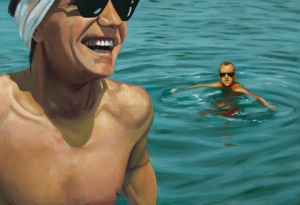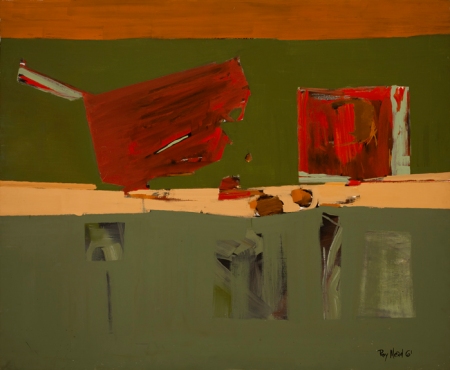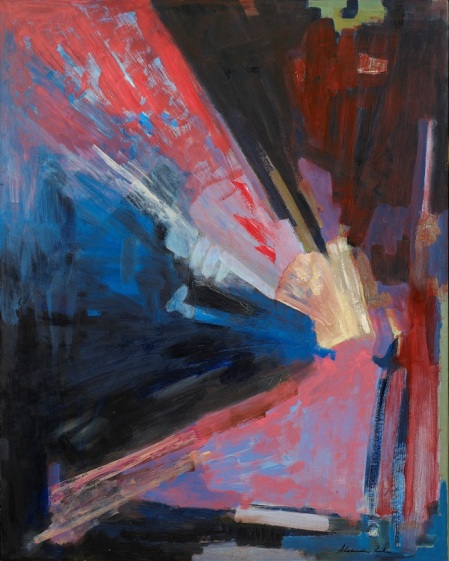Vol ‘n’ Tell is an ongoing series of blog posts written by RMG Volunteers. Raechel Bonomo is an Oshawa native, art enthusiast and second-year Print Journalism student at Durham College.
There are not many rooms in Oshawa with totem poles, fish swimming through space, and rolling Canadian hills up on its walls.
Evolving Form at the Robert McLaughlin Gallery (RMG) is the first major retrospective of Macdonald’s work in more than 30 years. The exhibit gives a fresh look into his influential career as a Canadian artist. According to the exhibit’s curator Linda Jansma, the exhibit came together through a long process that began in spring 2011. “This exhibit traces the artistic transition [Macdonald] underwent,” says Jansma. “His career as an artist journeys in a perpetual state of evolution.”
In 2012, Jansma was in the process of writing a grant to receive funding from the Department of Heritage for the exhibit when she received an email from Jock’s nephew, Alistair Macdonald. During their correspondence, he notified Jansma about 40 letters written by his uncle stored in the Edinburgh Gallery’s archives. This was the missing piece to Jansma’s puzzle, she said. That fall, she took a five-day trip to Scotland to view the letters. The content of the letters led her to uncover the lost work of Macdonald. She explored the various styles and periods of Macdonald and brought back with her paintings, drawings and methods unseen before by Canadian audiences currently up at the gallery.
Macdonald was born in 1897 in Thurso, Scotland. After his time in the army, he studied design at the Edinburgh College of Art. Macdonald immigrated to Canada in 1926 to take up a teaching job as head of design at the Vancouver School of Decorative and Applied Arts. One of his greatest contributions is as a founding member of Toronto-based abstract group, Painters 11 formed in 1953.
In the early stages of his career, Canadian Group of Seven member Lawren Harris’s work inspired Macdonald to paint abstract landscapes. This influence is visible in his work In the White Forest, 1932. You can see in his work Drying Herring Roe, 1938 Macdonald was inspired by Canadian Aboriginal culture. The painting features large traditional totem poles and reserves. These pieces, among 91 other original works, are currently up in the RMG.
“Intuitively artists create within the structural forms of nature,” is a quote from Macdonald posted above his landscape works in the exhibit. There is a notable predominance of nature as his main influencer in the majority of his work. Jock always painted the fourth dimension of nature,” says Jansma. “It is how we’re suppose to feel about it, not how we see it.”
Even when Macdonald wasn’t painting landscapes this influence is evident throughout his career. More abstract style paintings such as Spring Awakening, 1936 represent a more nonliteral interpretation of nature. In his mid-career, Macdonald began to divert away from traditional ideals of art and began to explore modern concepts such as futurism and surrealism.
In the 1940s, Macdonald met British surrealist artists Dr. Grace W. Pailthorpe and Ruben Mednikoff. They taught Macdonald surrealist painting methods such as automatics, a technique that involves painting in quick-paced series, and dating work down to the very time it was created. During this time, Macdonald was diverting away from his traditional landscape work and started producing surrealist-style paintings.
“Never can you know how indebted I am to you both, the awakening and releasing of my inner consciousness,” wrote Macdonald in a letter to Pailthorpe and Mednikoff.
Vivid, colourful painting such as Fish Family, 1943 display Macdonald’s subconscious expressed on a canvas. This piece and other works from this period are included in the RMG exhibit to showcase the versatility and dimensions Macdonald was capable of as an artist. The exhibit does a superb job at collecting and representing various elements and the periods of Macdonald’s career.
Many art historians credit 1957 – 1960 as Macdonald’s pre-eminent years as a painter. He began exploring oil-based mediums such as Duco and Lucite industrial paints to produce abstract work such as Bearer of Gifts, 1952. You can see the transition as his work began to loosen up in 1958 with Clarion Call into the very fluid and almost whimsical Elemental Fury, 1960.
The RMG dedicated an entire gallery space to showcase the work from his final years as a painter. From 1957, he painted an average of 50 paintings per year until he died suddenly from a heart attack on Dec. 3, 1960. The work of Macdonald has and continues to influence Canadian and international artists. The RMG’s exhibit Evolving Form adequately demonstrates the versatility, aptitude and depth of Macdonald’s career.
Image: Jock Macdonald, Nature’s Pattern, 1954; Collection of The Robert McLaughlin Gallery














